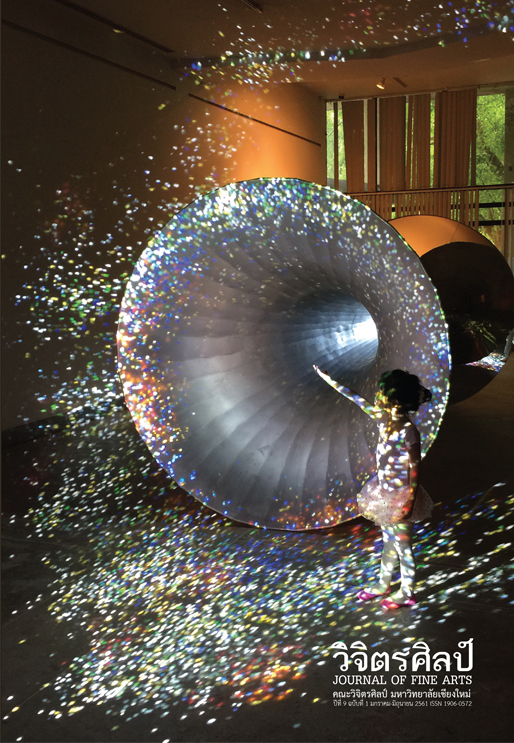รูปแบบเขตสังคมและวัฒนธรรมพิเศษชุมชนปกาเกอะญอฤๅษีคนต้นทะเล บ้านมอทะ-หม่องกว๊ะ ตำบลแม่จัน อำเภออุ้มผาง จังหวัดตาก
Main Article Content
Abstract
Special Socio-cultural Zone of Pgaz K’ Nyau hermit Kon Ton TA lay Community in Mor ta – Hmong Kwa village, Maejan sub district, Umphang district, Tak.
This study was directed at the cultural heritage of Pka K’ Nyau hermit community at Mor Ta -Hmong Kwa village and Type of Special Socio-cultural Zone in Pka K’ Nyau hermit Kon Ton Ta Lay Community at Mor Ta – Hmong Kwa village, Maejan Sub District, Umphang District, Tak Province.
This study used qualitative research methods, selecting 30 respondents covering different groups and sources of information including youth, housewives and Indigenous knowledge experts, to participate throughout the study. The participatory data collection approach included: community mapping, cultural calendar analysis, focus group discussions, in-depth interviews, transect walks, voice of seeds and participatory observation to observe the customs and ceremony of the community. To recheck the accuracy of information data triangulation and methodological triangulation were applied.
The results showed that the cultural heritage of the Pka K’ Nyau hermit community at Mor Ta -Hmong Kwa village hold the E-Si or the hermit as the highest spiritual leader, and also found that the Ton Tha lay have a philosophy of “the lazy.” Research also illustrated knowledge about watershed forests and conservation forests, the temple of the hermit, rotational farming as a sustainable agriculture system, hair as an aspect of identity of hermit religion, traditional cloth, community forests, inviting guests for meal, traditional weaving, tradition handicraft, local konjac and ma-ei, bamboo pagoda rituals and traditional stoves as the hearth of the house.
In the case of the Special Socio-cultural Zone in Pka K’ Nyau hermit Kon Ton TA lay Community at Mor Ta – Hmong Kwa village, Maejan sub district, Umphang district, Tak Province, the community has brought their cultural heritage into special-cultural zone showing that it has a special place in relation to the temple of the hermit acting as central hub since it is the center where community members meet, share and talk. It is the heart of community because the hermit who is their spiritual leader lives there and it is also the place where traditional and cultural celebrations and activities are organized.
Article Details
References
การปฏิรูปประเทศ. ข้อเสนอเพื่อส่งเสริมชุมชนกลุ่มชาติพันธุ์
เข้มแข็ง:กรณีกลุ่มชาติพันธุ์ชาวเล. กรุงเทพฯ: สำนักเลขาธิการ 3
สำนักงานเลขาธิการสภาผู้แทนราษฎร, 2559.
2. ชัชวาลย์ ทองดีเลิศ. แนวคิดการฟื้นฟูชีวิตชุมชนท้องถิ่น. กรุงเทพฯ: สถาบัน
พัฒนาองค์กรชุมชน, 2547.
3. ชยันต์ วรรธณภูติ. “คนเมือง: ตัวตน การผลิตซ้ำ สร้างใหม่และพื้นที่ทางสังคม
ของคนเมือง.” หน้า 33-37. ใน อนันท์ กาญจนพันธุ์ (บรรณาธิการ).
อยู่ชายขอบ มองลอดความรู้. กรุงเทพฯ: มติชน, 2549.
4. ปฐม หงษ์สุวรรณ. นานมาแล้ว มีเรื่องเล่า ตำนาน นิทาน ชีวิต. กรุงเทพฯ:
จุฬาลงกรณ์มหาวิทยาลัย, 2556.
5. ประเสริฐ ตระการศุภกร และคณะ. “นิยามและกระบวนการปฏิบัติการ เขต
พื้นที่วัฒนธรรมพิเศษในภาคเหนือตอนบนและข้อเสนอต่อแผนงาน
ต่อไป: วิถีกะเหรี่ยงกับปฏิบัติการฟื้นฟูสู่การปฏิรูป.” ใน เหลียวหลัง
แลหน้า มติครม. 3 สิงหาคม 2553. หอประชุม ศูนย์มานุษยวิทยาสิ
รินธร (องค์การมหาชน): ศูนย์มานุษยวิทยาสิรินธร (องค์การมหาชน)
กรุงเทพฯ, 16- 17 กุมภาพันธ์ 2558.
6. ปรีดา คงแป้น. “เขตวัฒนธรรมพิเศษชาวเล” 2556. สืบค้นเมื่อวันที่ 25 มีนาคม
2560. https://transbordernews.in.th/home/?p=3120.
7. นฤมล อรุโณทัย และคณะ. โครงการนาร่องอันดามัน และหน่วยวิจัยชน
พื้นเมืองและทางเลือกการพัฒนา สถาบันวิจัยสังคม จุฬาลงกรณ์
มหาวิทยาลัย และมูลนิธิเพื่อนชนเผ่า. กรุงเทพฯ: ศูนย์มานุษยวิทยา
สิรินธร, 2558.
8. แนวนโยบายและหลักปฏิบัติในการฟื้นฟูวิถีชีวิตชาวกะเหรี่ยง. กรุงเทพฯ: โรง
พิมพ์แห่งจุฬาลงกรณ์มหาวิทยาลัย, 2554
9. มาลี สิทธิเกรียงไกร. “พื้นที่เขตวัฒนธรรมพิเศษตามมติครม.” รายงานประจำ
ปี 2555-2556. ศูนย์ศึกษาชาติพันธุ์และการพัฒนา: วนิดาการพิมพ์,
3 สิงหาคม 2556.
10. ยศ สันตสมบัติ. อำนาจ พื้นที่ และอัตลักษณ์ทางชาติพันธุ์ การเมืองวัฒนธรรม
ของรัฐชาติในสังคมไทยภาคเหนือ. กรุงเทพฯ: ศูนย์มานุษยวิทยาสิริน
ธร, 2551.
11. วุฒินันท์ แท่นนิล. “การสร้างพื้นที่ทางสังคมเพื่อหลีกหนีความเป็นชายของ
ของคนพลัดถิ่น ชุมชนกะเหรี่ยงพลัดถิ่น ตำบลบ้านคา อำเภอบ้าน
คา จังหวัดราชบุรี.” วิทยานิพนธ์, ศาสตร์มหาบัณฑิต สาขาวิชาการ
จัดการภาครัฐและภาคเอกชน มหาวิทยาลัยศิลปกร, 2551.
12. ศูนย์พัฒนาและสงเคราะห์ชาวเขาจังหวัดแม่ฮ่องสอน. ข้อมูลชาวเขา:
แม่ฮ่องสอน. ม.ป.ท.: ศูนย์พัฒนาสังคมหน่วยที่ 43, 2548.
13. สถาบันวิจัยสังคม จุฬาลงกรณ์มหาวิทยาลัย. “บูรณาการแก้ไขปัญหาชาวเล
สู่การปฏิรูปประเทศ”. เอกสารการประชุมสัมมนาเชิงวิชาการ, ศูนย์
มานุษยวิทยาสิรินธร (องค์การมหาชน) กรุงเทพมหานคร, 10 - 11
พฤศจิกายน 2557.
14. สุรจิต สดศรีสายชล. “คุณค่าความหมายของพิธีกรรมมาบุโค๊ะ บ้านมอ
ทะ อำเภออุ้มผาง จังหวัดตาก.” วิทยานิพนธ์, ศิลปศาสตร์บัณฑิต
สาขาการจัดการภูมิวัฒนธรรม วิทยาลัยโพธิวิชชาลัย มหาวิทยาลัย
ศรีนครินทรวิโรฒ, 2557.
15. สุวิชาน พัฒนาไพรวัลย์. “การศึกษากระบวนการมีส่วนร่วมในการจัดทำ
พิพิธภัณฑ์เชิงนิเวศชุมชนเผ่าพื้นเมืองปกาเกอะญอ จังหวัดตาก.”
วิทยานิพนธ์, ดุษฎีบัณฑิต มหาวิทยาลัยศรีนครินทรวิโรฒ, 2559.
16. อภินันท์และกัญญานาฏ. “การขับเคลื่อนโยบายฟื้นฟูวิถีชีวิตชาว
กะเหรี่ยง.” เอกสารประกอบการสัมมนา. ศูนย์มานุษยวิทยาสิรินธร
กรุงเทพมหานคร, 2558.
17. โอปอล์ ประภาวดี. “ร้านน�้าชา: พื้นที่ของคนเมืองจังหวัดนครศรีธรรมราช กรณี
ศึกษาเขตเทศบาลเมืองนครศรีธรรมราช.” วิทยานิพนธ์, ศิลปศาสตร์
มหาบัณฑิต สาขาวิชามานุษยวิทยา มหาวิทยาลัยศิลปกร, 2547.
18. Davis Peter. “New Museologies and the Ecomuseum.” In the
Ash-gate Research Reader in Heritage and Identity, p.
397–414. Brian Grahamand and Peter Howard. Alderhot:
Ashgate, 2007.
19. Jennifer et al., “Local Renewables for Local Place?” In Making
Sense of Place Multidisciplinary Perspectives. Ian convery.
2nd ed. The International Center for Cultural & Heritage
Studies Newcastle University, 2014.
20. Lois Mansfeld. “Hill Farming Identities and Connection to place.”
In Making Sense of Place Multidisciplinary Perspectives. Ian
convery. 2nd ed. The International Center for Cultural &
Heritage Studies Newcastle University, 2014.
21. Rivard René. “Eco museums in Quebec Museum.” Sustainable
development in a World Heritage Area: The Ha Long Bay
Ecomuseum, 1985. Schwartz 37, 4 (April 2001): 202–205.
22. Vincent O’Brien et al., “Place Culture and Everyday Life in Kyrgyz
Villages.” In Making Sense of Place Multidisciplinary Perspectives. Ian convery. 2nd ed. The International Center
for Cultural & Heritage Studies Newcastle University, 2014.
บุคคลานุกรม
1. ขวัญชีวัน บัวแดง. สัมภาษณ์โดย สุวิชาน พัฒนาไพรวัลย์, สัมภาษณ์ทาง
โทรศัพท์, 14 เมษายน 2559.
2. สมหมาย ทรัพย์รังสิกุล. สัมภาษณ์โดย สุวิชาน พัฒนาไพรวัลย์, บ้านหม่องกว๊ะ
ตำบลแม่จัน อำเภออุ้มผาง จังหวัดตาก, 20 มีนาคม 2559.
3. โอภาส เมฆามรกต. สัมภาษณ์โดย สุวิชาน พัฒนาไพรวัลย์, บ้านหม่องกว๊ะ
ตำบลแม่จัน อำเภออุ้มผาง จังหวัดตาก, 20 มีนาคม 2559.
4. ประวัติ ศรีกนกสายชล. สัมภาษณ์โดย สุวิชาน พัฒนาไพรวัลย์, บ้านหม่องกว๊ะ
ตำบลแม่จัน อำเภออุ้มผาง จังหวัดตาก, 20 มีนาคม 2559.
5. พินิจ ดรรชนีนำชัย. สัมภาษณ์โดย สุวิชาน พัฒนาไพรวัลย์, บ้านมอทะ ตำบล
แม่จัน อำเภออุ้มผาง จังหวัดตาก, 21 มีนาคม 2559.
6. จอดาพอ สำราญเปรมปรี. สัมภาษณ์โดย สุวิชาน พัฒนาไพรวัลย์, บ้านมอทะ
ตำบลแม่จัน อำเภออุ้มผาง จังหวัดตาก, 21 มีนาคม 2559.
7. แป้แฮ ศรีโสภาสาคร. สัมภาษณ์โดย สุวิชาน พัฒนาไพรวัลย์, บ้านมอทะ ตำบล
แม่จัน อำเภออุ้มผาง จังหวัดตาก, 21 มีนาคม 2559.


